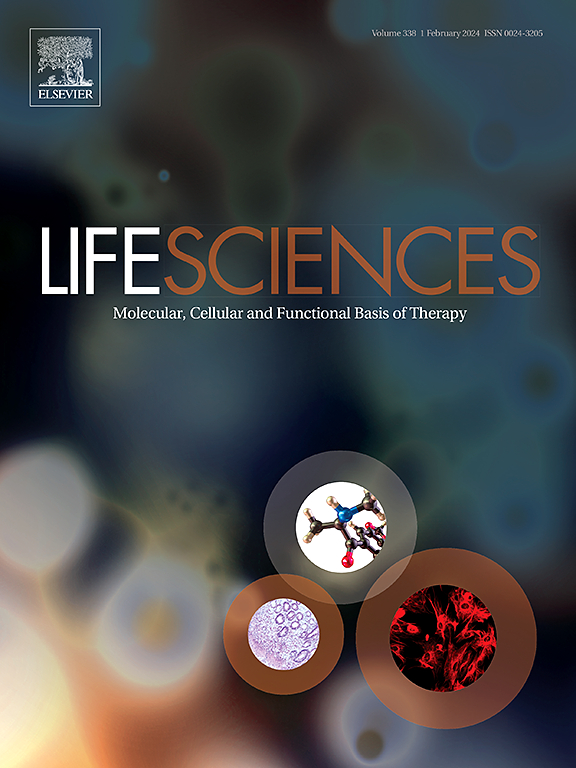aav2介导的ABD-FGF21基因传递在2型糖尿病小鼠中产生持续的降糖作用。
IF 5.2
2区 医学
Q1 MEDICINE, RESEARCH & EXPERIMENTAL
引用次数: 0
摘要
背景:成纤维细胞生长因子 21(FGF21)是一种天然存在的多肽激素,参与调节糖脂代谢,有望成为 2 型糖尿病(T2DM)的潜在治疗药物。然而,原生 FGF21 的半衰期短、药代动力学差,限制了其降低体内高血糖的疗效。因此,维持 FGF21 稳定和持续的血药浓度对其作为体内糖脂代谢的有效调节剂至关重要。在这项研究中,我们开发了一种以 AAV2 为介导的基因递送系统,该系统结合了与 FGF21 融合的白蛋白结合域(ABD),并在 2 型糖尿病小鼠模型中评估了其效果:方法:将质粒 pAAV-FGF21-荧光素酶、pHelper 和囊膜质粒转染到 HEK293T 细胞中,生成重组 AAV(rAAV)病毒。为进行评估,建立了 2 型糖尿病(T2DM)小鼠模型。小鼠通过尾静脉注射 rAAV。使用商业试剂盒评估了注射 rAAV 对各种参数的影响。使用苏木精和伊红(H&E)染色法检测 T2DM 小鼠肝脏和脂肪组织的组织学变化:数据显示,加入 ABD 能显著延长 FGF21 在小鼠血清中的半衰期。此外,以AAV2为媒介将ABD-FGF21输送到肝脏可使小鼠体内的基因持续表达,并显著提高循环中FGF21的水平。用AAV2-ABD-FGF21治疗T2DM小鼠可带来多种益处,包括降低空腹血糖、改善胰岛素敏感性、降低甘油三酯和总胆固醇水平以及改善体重。此外,血清分析和组织学检查显示,七周后的研究终点没有发现明显的肝损伤:总之,我们开发了一种利用 AAV 载体生产长效 FGF21 的新策略,AAV2-ABD-FGF21 有希望成为治疗 2 型糖尿病和其他糖脂代谢紊乱的一种方法。本文章由计算机程序翻译,如有差异,请以英文原文为准。
AAV2-mediated ABD-FGF21 gene delivery produces a sustained anti-hyperglycemic effect in type 2 diabetic mouse
Background
Fibroblast Growth Factor 21 (FGF21) is a naturally occurring peptide hormone involved in the regulation of glycolipid metabolism, and it shows promise as a potential treatment for type 2 diabetes mellitus (T2DM). However, the short half-life and poor pharmacokinetics of native FGF21 limit its efficacy in reducing hyperglycemia in vivo. Therefore, maintaining stable and sustained blood concentrations of FGF21 is crucial for its role as an effective regulator of glycolipid metabolism in vivo. In this study, we developed an AAV2-mediated gene delivery system incorporating an Albumin-binding domain (ABD) fused to FGF21, and we evaluated its effects in a type 2 diabetic mouse model.
Methods
The plasmids pAAV-FGF21-Luciferase, pHelper, and the capsid plasmid were transfected into HEK293T cells to generate recombinant AAV (rAAV) virus. A type 2 diabetes mellitus (T2DM) mouse model was established for evaluation. The rAAV was administered via tail vein injection into the mice. The effects of rAAV injection on various parameters were assessed using commercial kits. Histological changes in the liver and adipose tissue of T2DM mice were examined using hematoxylin and eosin (H&E) staining.
Results
The data showed that the inclusion of ABD significantly prolonged the half-life of FGF21 in the serum of mice. Additionally, AAV2-mediated delivery of ABD-FGF21 to the liver resulted in sustained gene expression and a significant increase in circulating FGF21 levels in mice. Treatment with AAV2-ABD-FGF21 led to several benefits, including reduced fasting glucose, improved insulin sensitivity, decreased triglyceride and total cholesterol levels, and improved body weight in T2DM mice. Furthermore, serum analysis and histological examination showed no significant liver damage at the study endpoint after seven weeks.
Conclusion
In conclusion, we have developed a novel strategy for producing long-acting FGF21 using the AAV vector, and AAV2-ABD-FGF21 shows promise as a therapeutic approach for type 2 diabetes mellitus and other glycolipid metabolic disorders.
求助全文
通过发布文献求助,成功后即可免费获取论文全文。
去求助
来源期刊

Life sciences
医学-药学
CiteScore
12.20
自引率
1.60%
发文量
841
审稿时长
6 months
期刊介绍:
Life Sciences is an international journal publishing articles that emphasize the molecular, cellular, and functional basis of therapy. The journal emphasizes the understanding of mechanism that is relevant to all aspects of human disease and translation to patients. All articles are rigorously reviewed.
The Journal favors publication of full-length papers where modern scientific technologies are used to explain molecular, cellular and physiological mechanisms. Articles that merely report observations are rarely accepted. Recommendations from the Declaration of Helsinki or NIH guidelines for care and use of laboratory animals must be adhered to. Articles should be written at a level accessible to readers who are non-specialists in the topic of the article themselves, but who are interested in the research. The Journal welcomes reviews on topics of wide interest to investigators in the life sciences. We particularly encourage submission of brief, focused reviews containing high-quality artwork and require the use of mechanistic summary diagrams.
 求助内容:
求助内容: 应助结果提醒方式:
应助结果提醒方式:


